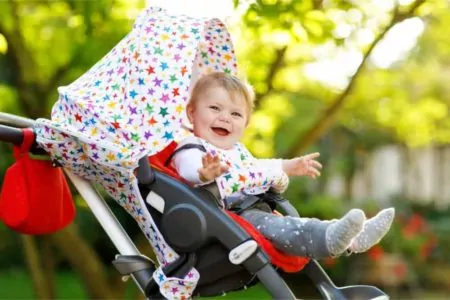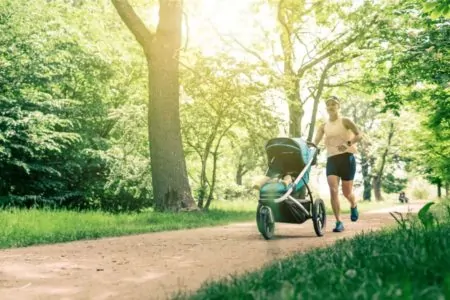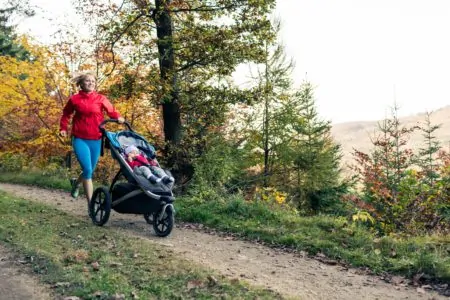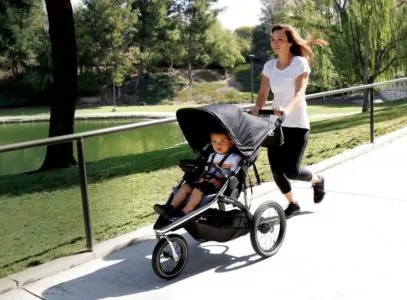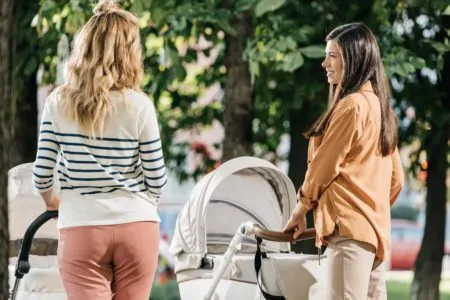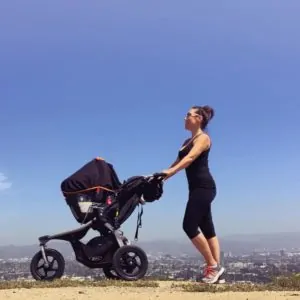Is summer approaching, and you’re afraid you will be on lockdown because of the heat? You don’t have to be. You can get your vitamin D fix by going outside while still keeping your baby cool in a stroller.
Yes, it’s important that babies don’t overheat or get a sunburn, but there are things you can do to avoid this.
Key Takeaways
- Provide shade with a stroller cover to protect from UV rays and keep your baby cool.
- Dress your baby in lightweight, loose cotton clothing and a broad-rimmed hat for sun protection.
- Ensure your baby stays hydrated through breastfeeding, formula, or water (for babies over 6 months).
- Use stroller seat liners or fans, and remove back panels to increase airflow and prevent overheating.
How to Keep Your Child Cool in the Stroller
Here are some ways to ensure your baby stays cool and enjoys some fresh air. You may want to go outside during the coolest times of the day, usually early morning and late afternoon. Avoid peak sun time from 10 a.m. to 2 p.m.
1. Provide a Shady Haven
Strollers generally come with a canopy, but these can be lacking when it comes to providing full shade from the sun. Invest in a sunshade designed for strollers to protect your baby from harsh UV rays and keep them cool.
These covers can shield your little one from up to 99% of the sun’s harmful UVA and UVB rays. This is important as sunburn can lead to a greater risk of skin cancer later in life (1).
Many of these covers are made from a lightweight material, letting air get to your child.
The extended coverage of these covers or canopies, like this one from Summer Infant, ensures no sun gets in, no matter the time of day. They are generally suitable for most brands of strollers and are quick and easy to attach.
They can also be water repellent, doubling as a rain cover. Some even have storage pockets, which are handy for keeping extra hydrating drinks on board.
Don’t be tempted to use a blanket, even a muslin one, draped over the stroller to provide shade. This can be dangerous as the temperature inside the stroller will rise.
2. Sensible Clothing
Babies and young children are still developing and can’t regulate their body temperature easily. They tend to conserve more heat, which can lead to overheating (2).
Overdressing your little one can also lead to heat rashes. Conversely, underdressing can lead to sunburn or heatstroke.
Lightweight, loose cotton clothing that covers their arms and legs are good items to pick (3). The cotton is breathable and will wick moisture away from their skin, helping them lose some of that heat.
Another fabric that is becoming increasingly popular is bamboo. It absorbs sweat from the skin, but unlike cotton, it doesn’t retain it. The moisture is released from the fabric so it can evaporate.
Lighter colors are also preferable as they reflect light more than darker colors.
One final consideration is how useful a hat is. One with a broad rim that covers the neck and ears is ideal.
A popular choice is this one from I Play. It gives good coverage and ties under the chin. This helps keep the hat on, but unlike elastic strings, it won’t interfere with circulation.
3. Keep the Fluids Flowing
Dehydration is a major consideration when the temperature gauge rises. It can be dangerous if your baby is not getting enough fluids (4). They will lose moisture through sweating, so increasing fluid intake is a must.
Breastfed babies get all the hydration they need from your milk (5). Increasing the amount you breastfeed your little one when it’s hot will help prevent dehydration.
Formula-fed babies will need extra formula, and babies over the age of 6 months may need extra water. However, do not give more than a 4 oz bottle of extra water.
You can monitor whether your baby is getting dehydrated by checking how many wet diapers they have compared to normal. Stronger-smelling, dark-colored urine also indicates they might not be getting enough fluids (6).
4. Get a Stroller Seat Liner
While you might think this would make your baby hotter and is just for use in colder times, it’s not the case. Many stroller seat liners, like this one from Ecotyl, are designed to wick moisture and keep your baby cool and comfortable.
Some liners are made from breathable fabrics and have absorbent cushioning. This will prevent overheating and sweating. Quick and easy to install, a liner is a good accessory for summer strolls.
Some stroller liners are filled with a gel designed to keep your baby cool. They work by dissipating the heat from the skin.
Although they don’t actually need it, you could refrigerate the liners for a few minutes before use to add a cooling effect.
5. Circulate Air With a Stroller Fan
We all appreciate having a fan on us when the weather gets steamy and hot. Why not get your baby their own personal fan that can be attached to their stroller? They tend to be battery operated and can be fitted to the stroller.
One of our favorites is this one from Comlife. It has a strong clip that attaches quickly and easily to your stroller. As well as the cooling from an oscillating fan, the baby will love the white noise or watching the movement.
The bonus of a stroller fan is you can also use it indoors. Set it up to circulate air in the nursery, keeping your baby cool during daytime naps or hot summer nights.
6. Increase Airflow by Removing the Back Panel
Some strollers have a removable back panel. Take this off to increase airflow around your baby and keep them cooler.
7. Homemade Cooling Systems
You have a few options for a homemade solution:
- Used water bottles.
- Cooler packs.
- Wet towels.
Water Bottles
- Fill water bottles about two-thirds full with water.
- Wrap them in a towel, and place them in the side of the stroller.
- Make sure your little one can’t unscrew the cap. This could be a choking hazard.
Cooler Packs
Simply place cooler packs or pads under a cushion in the stroller.
Wet Towels
Wipe your baby down with the towel. As the air hits their wet skin, it will refresh and cool them.
How To Tell If Baby Is Overheating
Here are some signs you can look out for that might indicate your baby is getting too hot:
- The face might be flushed and red.
- Skin feels drier than usual to the touch.
- Less wet diapers than usual.
- More irritable than usual, or they feel floppy and are lethargic.
- Refusing to drink.
- The fontanelle (soft spot on the top of the head) appears sunken.
If you suspect your baby is overheating, with or without any of these symptoms, get some medical advice.
Some Do’s and Don’ts
We have already mentioned this, but it’s important: Don’t use a blanket to shade a stroller. While it might keep the sun off, it will also keep the heat in, leading to your baby getting too hot.
Don’t go out in the midday sun. Try to time your trips for when it’s cooler in the morning or the afternoon.
Do walk in the shade whenever you can, or find a shady spot if you decide to stop. Look for a tree with overhanging branches in a park, or find the shade of a large building if you’re in the city.
